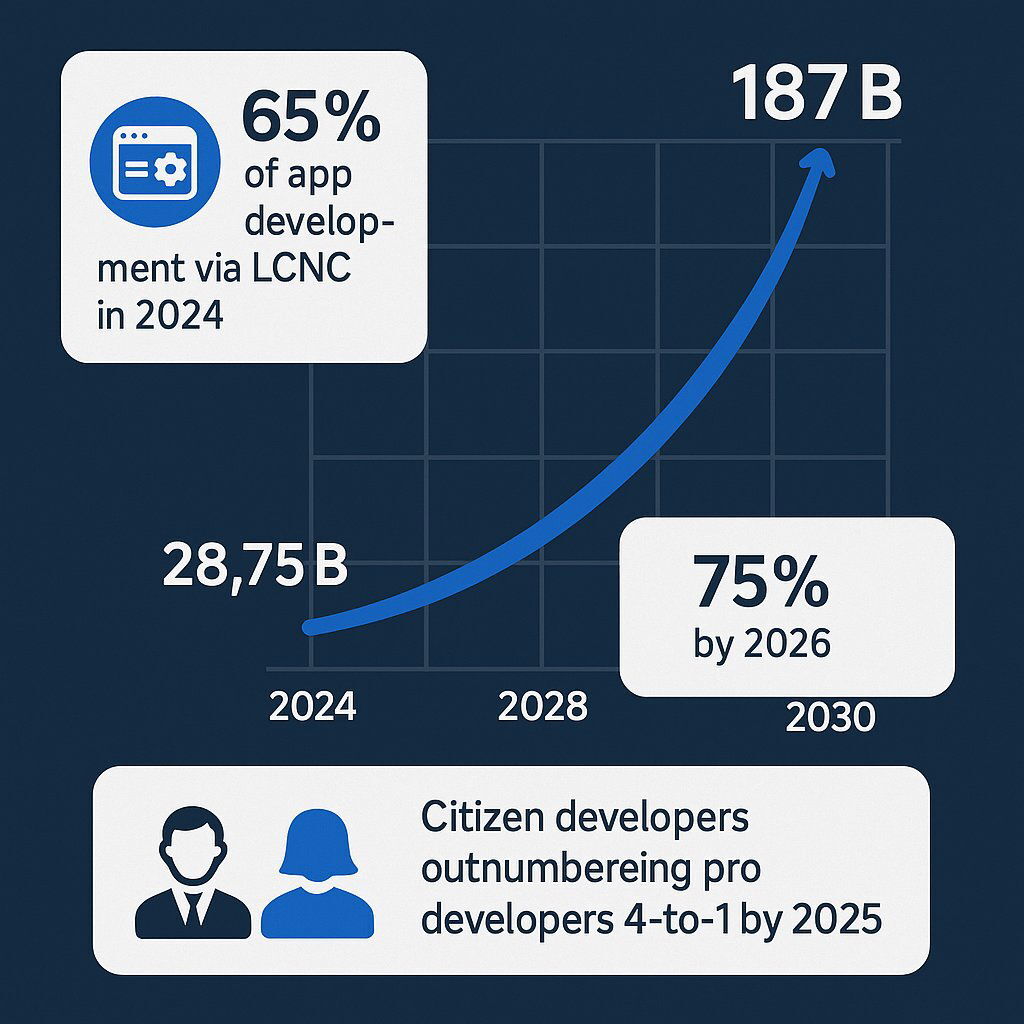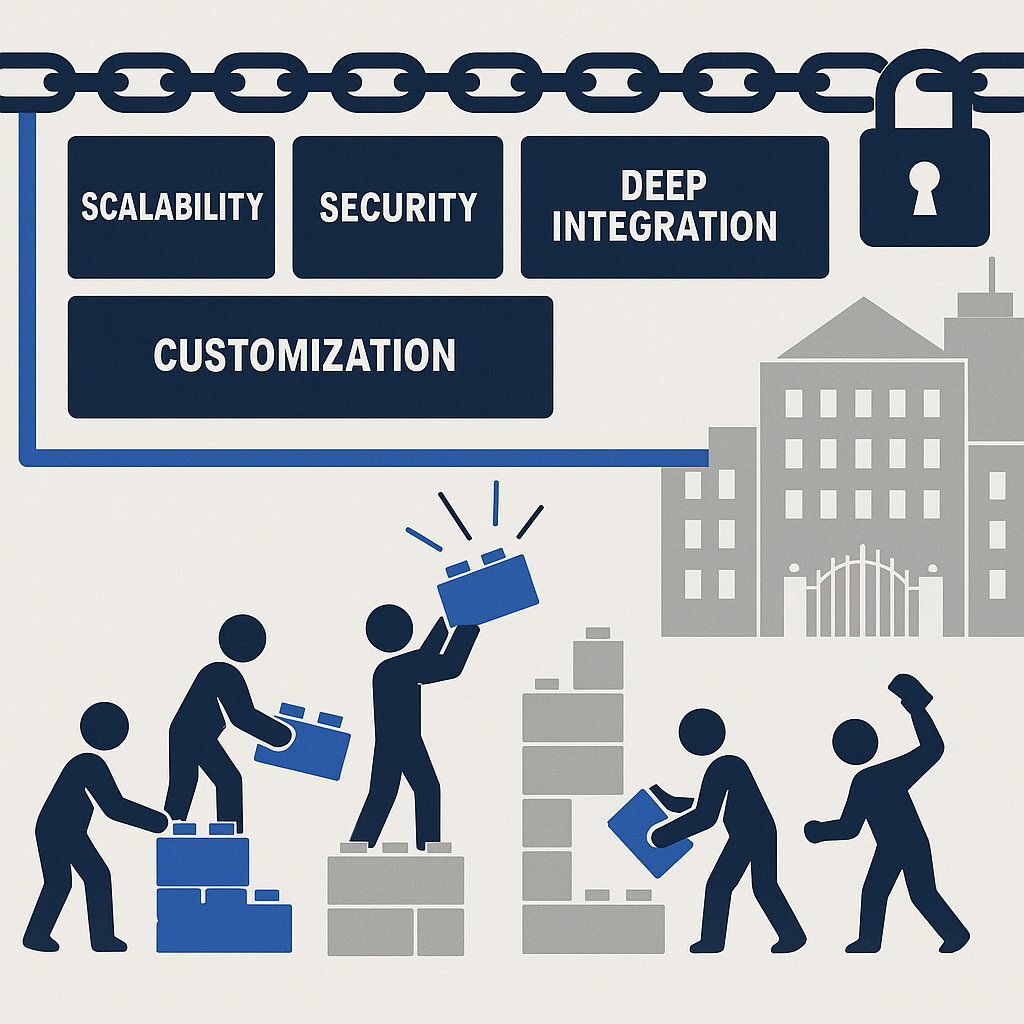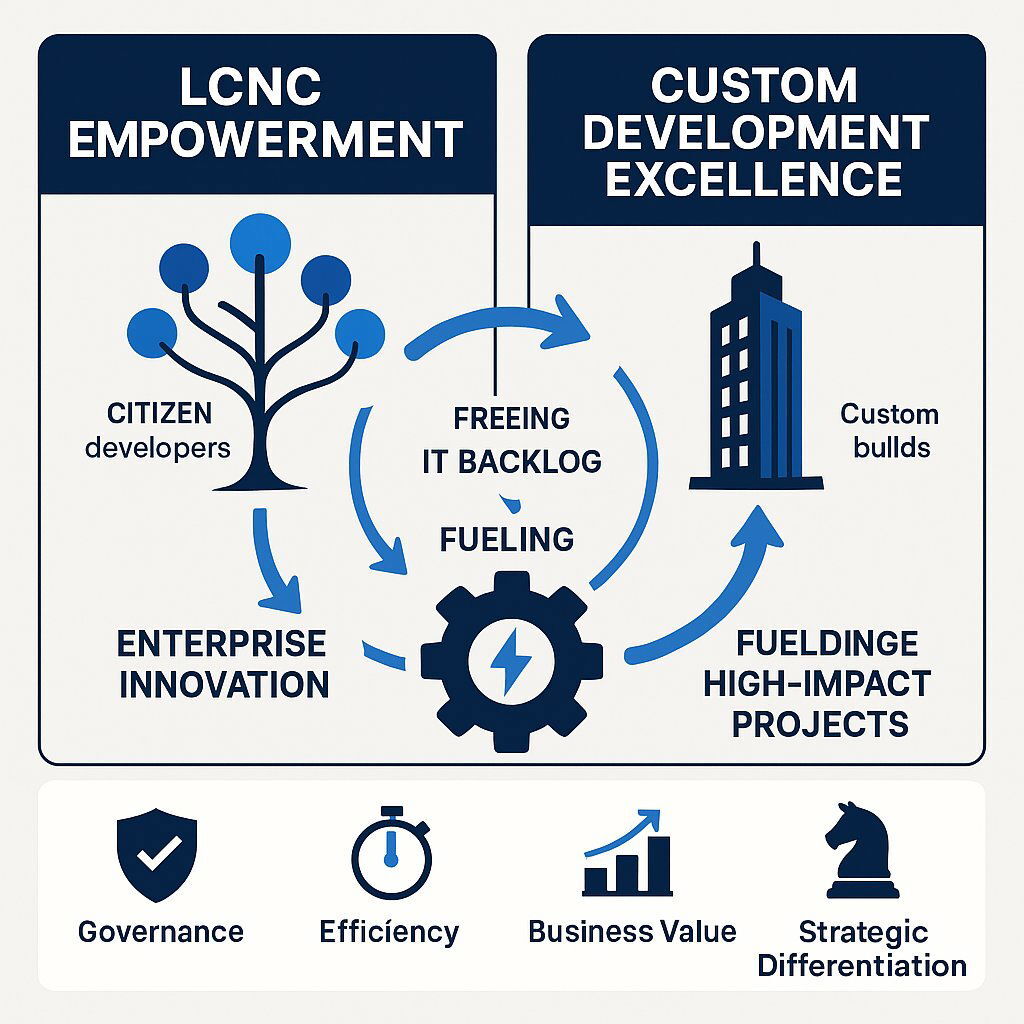
Low-Code vs. Custom Development: How Tech Leaders Can Win with a Hybrid Strategy
October 12, 2025 / Bryan ReynoldsThe Question on Every Tech Leader's Mind
If you're a CTO, CIO, or business leader, you've seen the headlines. You've sat through the demos and fielded the calls from vendors promising to democratize development. The low-code/no-code (LCNC) movement is no longer a fringe concept; it's a full-blown industry tsunami, with staggering growth projections and aggressive marketing campaigns. The question is no longer "What is low-code?" but a far more pressing one: "What does this mean for my business, my budget, and my high-priced, elite custom development talent?"
This conversation is too often trapped in a flawed binary. On one side, LCNC is hailed as a silver bullet for digital transformation, a "developer-killer" that will render traditional coding obsolete. On the other, it's dismissed as a toy, a glorified spreadsheet macro incapable of handling serious enterprise workloads. Both views miss the point entirely.
This report argues that this binary perspective is a strategic error. The rise of LCNC is not a threat to your custom development team; it is its greatest strategic enabler. It is a powerful tool for ruthless prioritization, allowing you to finally separate the "tactical noise" of internal requests from the "strategic signal" of market-differentiating projects. By empowering your business units to solve their own tactical problems with speed and agility, you liberate your most valuable engineers to focus on what they do best: building your company's future.
An Irreversible Shift: The Data Behind the LCNC Tsunami
To formulate a strategy, one must first accept the reality on the ground. The momentum behind the LCNC movement is not just hype; it is an irreversible market shift backed by overwhelming data. Ignoring this trend is no longer a viable option for any forward-thinking enterprise.

The market growth projections alone paint a picture of exponential adoption. The global low-code market is forecasted to explode from approximately $28.75 billion in 2024 to an astonishing $187 billion by 2030, advancing at a compound annual growth rate (CAGR) of over 31%. Forrester corroborates this trajectory, projecting a market size approaching $50 billion by 2028. This is not a niche segment; it is rapidly becoming a dominant force in how enterprise software is created.
More critically, LCNC is fundamentally altering the means of application production. Gartner forecasts that by 2024, LCNC tools will be responsible for over 65% of all application development activity. By 2026, that number climbs to 75% of new enterprise applications being built with these technologies—a monumental leap from less than 25% in 2020.
Driving this explosive growth is a new class of builder: the citizen developer. These are business users, often outside of formal IT departments, who leverage LCNC platforms to create their own solutions. By 2026, these non-IT professionals will account for at least 80% of the user base for low-code development tools. Gartner predicts that within large enterprises, the number of active citizen developers will soon outnumber professional developers by a staggering four-to-one ratio. This is not "shadow IT" to be feared, but a decentralized, business-led revolution in problem-solving that must be harnessed.
| Metric | 2024 Projection | 2030 Projection | Key Analyst & Source |
|---|---|---|---|
| Global Market Size | ~$28.75 Billion | $187 Billion | GlobeNewswire, Tadabase |
| Compound Annual Growth Rate (CAGR) | ~32% | ~31% | Grand View Research, GlobeNewswire |
| % of New Apps Built with LCNC | >65% (by 2024) | >75% (by 2026) | Gartner |
| Citizen Developers vs. Pro Developers | 4x more Citizen Developers at large enterprises (by 2025) | N/A | Gartner |
This tsunami of adoption is not happening in a vacuum. It is a direct and powerful market response to a chronic, systemic problem that every technology leader faces: the immense and growing gap between the business's demand for digital solutions and IT's capacity to deliver them. The demand for business applications is growing at least five times faster than the available IT capacity to build them. This is compounded by a global shortage of skilled software engineers and the high cost of retaining them, with average developer salaries in the U.S. exceeding $100,000. The insatiable demand from business units, coupled with the supply-side constraint of a hyper-competitive talent market, created a perfect storm. LCNC platforms have emerged as the economic and practical solution to this fundamental market imbalance. For a CTO, this reframes the technology not just as a tool, but as a strategic staffing and resource allocation solution—a way to de-risk your dependency on the talent market for non-critical tasks.
This reality forces a fundamental evolution in the role of the central IT department. With 80% of LCNC users expected to be non-IT professionals by 2026, the old model of IT as the sole gatekeeper and builder of applications is obsolete. The impulse for business units to self-serve is unstoppable; attempting to block it is a futile and counterproductive exercise. The only viable strategy is to guide it. This requires a massive cultural and operational shift for the CIO and CTO, whose roles must evolve from being a "chief builder" to a "chief enabler and governor." The primary function of the modern IT department in this new world is to select, secure, and manage a portfolio of approved LCNC platforms, provide robust training, and establish the "guardrails" within which citizen developers can safely and effectively innovate.
The Power of "Good Enough": Where LCNC Delivers Immediate Business Value
Now that the scale of the LCNC movement is clear, it is crucial to understand why it is happening. The tangible, ground-level benefits of these platforms are driving their adoption, and for a specific class of problems, LCNC is not just a viable option—it is the superior choice. The core theme is delivering speed and efficiency for the "long tail" of application needs that have historically clogged IT backlogs.
The primary value proposition is radical speed. LCNC platforms can reduce application development time by as much as 90% compared to traditional hand-coding. This is not a theoretical number. Real-world case studies demonstrate this velocity in action: Schneider Electric launched 60 applications in just 20 months, with most delivered in under 10 weeks. In the highly regulated financial sector, thinkmoney delivered a modern mobile banking experience in a mere 14 weeks. This speed is not just an IT metric; it is a direct enabler of business agility, allowing the organization to respond to market changes and internal needs at an unprecedented pace.
This velocity has a profound and immediate impact on the most persistent pain point for IT leaders: the project backlog. An estimated 72% of IT leaders report that their project backlogs prevent them from working on strategic, high-value initiatives. LCNC directly attacks this problem. By empowering business users to build their own solutions, it offloads a significant portion of the request queue from the central IT team. The data shows this works: 90% of professional developers who adopt LCNC report that it helps them manage and reduce their backlogs. This is not merely about clearing tickets; it is about reclaiming the strategic capacity of your most expensive talent.
The data is also remarkably consistent on the ideal use cases where LCNC excels. These are not complex, mission-critical systems, but the essential connective tissue of a modern enterprise:
- Forms and data-collection apps (58% of use cases)
- Apps that orchestrate business processes and workflows (49%)
- Apps that replace paper, email, or spreadsheets (42%)
- Customizing the user interface for existing on-premise applications (22%)
The return on investment for tackling these use cases is clear and compelling. One Forrester study found that the average company avoided hiring two full-time IT developers by using LCNC tools, reaping approximately $4.4 million in increased business value over a three-year period. In another case, electronics giant Ricoh achieved a 253% ROI on their LCNC investment, with a full payback in just seven months.
A crucial distinction emerges from this data. The top use cases—forms, internal workflows, spreadsheet replacement—reveal that LCNC is primarily a tool for operational digitization , not necessarily for digital transformation . It is exceptionally good at taking existing internal operations and making them run better, faster, and cheaper. However, it is not, on its own, a tool for creating disruptive, market-facing new business models or products. This is supported by the fact that 31% of enterprises using LCNC have not yet used it to build and deliver their highest-value applications. The value is framed in terms of efficiency gains, backlog reduction, and cost savings. For business leaders, this provides a clear mandate: position LCNC internally as a powerful operational excellence tool. This framing helps justify the investment while setting realistic expectations that it will not, by itself, create the company's next billion-dollar revenue stream. That requires a different toolset.
Hitting the Ceiling: A CTO's Guide to the Hard Limits of Low-Code
To build a credible strategy, one must be brutally honest about a technology's limitations. Understanding the failure points of LCNC is just as critical as understanding its benefits. This is not a critique of the technology itself but a necessary exercise in defining its operational envelope. For a CTO, knowing where these platforms hit a hard ceiling is essential for risk management and proper resource allocation.

Scalability and Performance: This is a primary concern for 47% of organizations evaluating LCNC platforms. While adequate for departmental workflows, these platforms can hit performance ceilings when dealing with large datasets, high transaction volumes, or heavy concurrent user loads. The auto-generated code and pre-built components that provide speed often cannot be fine-tuned and optimized for the demands of a mission-critical, enterprise-wide system.
Security and Compliance: In regulated industries like finance and healthcare, this can be a deal-breaker. LCNC platforms can present a "black-box" nature, making it difficult to perform granular security audits or verify compliance with stringent regulations like HIPAA or GDPR. While platforms are improving, the onus is on the enterprise to validate these claims, and 25% of companies cite security as a key concern when adopting LCNC.
Complex Integrations: Modern enterprises are a web of interconnected systems. While LCNC platforms boast libraries of pre-built connectors, they often struggle with deep, bespoke integrations into legacy systems, proprietary databases, or complex microservice architectures. Their predefined integration points may not align with the unique, and often messy, reality of an established enterprise IT landscape.
Limited Customization and Control: This is the fundamental trade-off at the heart of LCNC. The speed and accessibility come from abstraction—from using pre-built templates and components. This inherently limits the depth of customization possible. Businesses with unique operational workflows, highly specific UI/UX requirements, or the need to implement proprietary algorithms will quickly find themselves constrained by the platform's boundaries.
Vendor Lock-In: This is a significant long-term strategic risk. Adopting an LCNC platform means building business processes on proprietary technology. This creates a powerful dependency, as migrating applications and the associated business logic off one platform and onto another can be technically challenging, costly, and time-consuming. It is a major concern for 37% of organizations.
These limitations point to a deeper strategic consideration: the "proprietary ecosystem" risk. When an enterprise adopts an LCNC platform, it is not just buying a tool; it is buying into that vendor's specific technological worldview—its prescribed way of handling data models, business logic, and system integrations. The applications built become artifacts of that ecosystem, with restricted access to the underlying code. This makes the choice of an LCNC platform a major architectural decision with long-term consequences. A CTO must evaluate not just a platform's current features, but its long-term roadmap, its philosophy on interoperability, and have a clear "exit strategy" in mind before committing significant resources. This risk is also why 75% of large enterprises are expected to use at least four different LCNC development tools, creating a diversified portfolio to avoid over-reliance on a single vendor.
The Unassailable Domain of Custom Development
Having clearly defined the ceiling of LCNC, we can now define the unassailable domain of custom development. This is where the conversation elevates from operational efficiency to strategic differentiation. For a specific class of applications, custom development is not merely an alternative; it is the only viable path to building a true, defensible competitive advantage.
This is the realm of the "crown jewels"—the mission-critical, high-performance, customer-facing applications that directly generate revenue and embody the company's unique intellectual property. A fintech platform architected to process millions of secure transactions per day, a proprietary logistics algorithm that optimizes a global supply chain, or a cutting-edge gaming engine delivering a unique user experience—these are systems that cannot be assembled from a generic, one-size-fits-all toolkit.
The core advantages of custom development directly address the limitations of LCNC:
- Complete Control and Ownership: Custom development provides absolute control over the architecture, performance tuning, security posture, and codebase. This eliminates the risk of vendor lock-in and ensures that the valuable intellectual property created is owned entirely by the business.
- Unmatched Performance and Scalability: Custom solutions are engineered from the ground up for specific performance targets and designed to handle enterprise-level scale and complexity. The architecture can be purpose-built to grow with the business, not constrained by a platform's limitations.
- Seamless, Deep Integration: Custom code allows for robust, precisely tailored integrations with any system—be it a modern third-party API, a homegrown legacy database, or a complex web of microservices. This creates a truly unified and efficient technology stack.
This is precisely where a philosophy of a Tailored Tech Advantage becomes critical. For a company's most strategic assets, an off-the-shelf solution is an inherent compromise. True market leadership requires solutions that are custom-crafted with cutting-edge, enterprise-grade technologies—like a robust CI/CD pipeline in Azure DevOps, a scalable container orchestration layer with Kubernetes, and a high-performance Postgres database. These projects demand a Rapid Agile Deployment methodology that is both timely and adaptive, where enterprise-grade quality is not just a feature, but the foundational principle. This is the exclusive and essential domain of your elite development talent.

| Criteria | Low-Code/No-Code (LCNC) | Custom Development |
|---|---|---|
| Ideal Use Case | Internal process automation, departmental workflows, data collection | Mission-critical systems, customer-facing products, sources of competitive IP |
| Speed-to-Market | Extremely Fast (Days/Weeks) | Slower, More Deliberate (Months/Years) |
| Primary Goal | Operational Efficiency & Backlog Reduction | Strategic Differentiation & Revenue Generation |
| Customization | Limited by platform templates and components | Unlimited; tailored to exact business needs |
| Scalability | Suitable for small to medium scale; can face performance limits | Highly scalable; designed for enterprise growth and high transaction volume |
| Integration | Basic, connector-driven integrations | Deep, seamless integration with any system, including legacy |
| Control & IP | Vendor-dependent; risk of lock-in | Full ownership and control of code and intellectual property |
| Key Talent | Citizen Developers, Business Technologists | Elite Software Engineers, Architects, DevOps Specialists |
The Hybrid Blueprint: A Two-Pronged Strategy for Digital Dominance
The smartest organizations will not choose between LCNC and custom development. They will do both, implementing a hybrid blueprint that creates a powerful, symbiotic relationship between operational speed and strategic precision. This two-pronged strategy allows the enterprise to move faster and build better, simultaneously.
Pillar 1: Empower Business Units with Governed LCNC
The first pillar involves formally sanctioning and rolling out a curated portfolio of LCNC platforms for business units. The goal is to empower departments like Marketing, Sales, HR, and Finance to build their own solutions for internal process automation, data collection, and workflow management. This fosters a culture of innovation, ownership, and rapid problem-solving at the edges of the organization.
However, empowerment without oversight leads to chaos. The role of IT here is not to build, but to govern. A central IT team must establish a "Center of Excellence" responsible for vetting and approving platforms, ensuring they meet enterprise security and compliance standards, managing integrations with core systems, and providing training and best practices. This model prevents the proliferation of ungoverned "shadow IT" while still capturing the benefits of decentralized innovation.
Pillar 2: Unleash Your Elite Developers on Strategic Imperatives
With business units self-serving on tactical needs, the second pillar is to officially refactor the mission of the professional development team. Their charter is no longer to build simple CRUD apps or internal forms. Their exclusive focus must be on the complex, high-value, custom-built systems that create the company's Tailored Tech Advantage.
This shift has a profound impact. It dramatically increases the return on investment for high developer salaries by ensuring this expensive talent is focused solely on work that generates revenue and differentiates the company in the marketplace. Furthermore, it significantly boosts morale and retention. Elite engineers are energized by solving difficult, meaningful problems, not by clearing a backlog of mundane, repetitive requests.
These two pillars are not independent; they are mutually reinforcing. When the business can self-serve on simpler tasks (Pillar 1), it drastically reduces the volume of requests hitting the central IT backlog. This, in turn, frees up the elite development team's time and cognitive bandwidth to focus exclusively on the strategic work defined in Pillar 2. This creates a virtuous cycle of accelerated delivery and increased innovation across the entire organization.
Conclusion: LCNC Isn't a Threat—It's a Strategic Enabler
Viewing the low-code/no-code revolution and the discipline of custom development as adversaries is a strategic error. The data and market trends point to a clear and powerful conclusion: LCNC is unequivocally an opportunity .
It is an opportunity to reallocate your most precious resources—the time and talent of your best engineers—away from low-value maintenance and toward high-impact innovation. It is an opportunity to accelerate operational efficiency across every department, empowering the people closest to a problem to build their own solutions. And it is an opportunity to build a more agile, responsive, and innovative organization, capable of both optimizing current operations and inventing future ones.
For technology and business leaders, the path forward is clear. It is not a matter of choosing one path over the other, but of architecting a hybrid strategy that leverages the best of both worlds.
Actionable Next Steps for Leaders:
- Audit Your Backlog: Use the decision matrix framework to systematically classify every project in your current and future backlog. Label each initiative as either "Operational Efficiency" (a candidate for LCNC) or "Strategic Differentiation" (requiring custom development). This simple act will bring immediate clarity to your resource allocation. For a budgeting perspective, see our custom software budgeting guide.
- Establish Governance: Begin the process of creating an LCNC Center of Excellence today. Define your policies for platform selection, security reviews, data access controls, and citizen developer support. Proactive governance is the key to unlocking the power of LCNC safely. For more, explore our enterprise AI governance framework.
- Redefine Your A-Team's Mission: Formally communicate a new, focused charter to your core development team. Challenge them with the complex, high-impact projects that will define your company's future. Make it clear that their value lies not in the volume of tickets they close, but in the strategic advantage they build.
When you have identified those mission-critical projects that demand enterprise-grade quality and a true tailored advantage, that's where a partner with deep expertise in custom software development comes in. Let's talk about building your competitive edge.
Further Reading
- https://www.hostinger.com/tutorials/low-code-trends
- Low-code platforms reduce backlogs for 90% of developers
- https://medium.com/@arwazshaikh/low-code-vs-custom-development-the-best-choice-for-2025-1664045005da
About Baytech
At Baytech Consulting, we specialize in guiding businesses through this process, helping you build scalable, efficient, and high-performing software that evolves with your needs. Our MVP first approach helps our clients minimize upfront costs and maximize ROI. Ready to take the next step in your software development journey? Contact us today to learn how we can help you achieve your goals with a phased development approach.
About the Author

Bryan Reynolds is an accomplished technology executive with more than 25 years of experience leading innovation in the software industry. As the CEO and founder of Baytech Consulting, he has built a reputation for delivering custom software solutions that help businesses streamline operations, enhance customer experiences, and drive growth.
Bryan’s expertise spans custom software development, cloud infrastructure, artificial intelligence, and strategic business consulting, making him a trusted advisor and thought leader across a wide range of industries.


